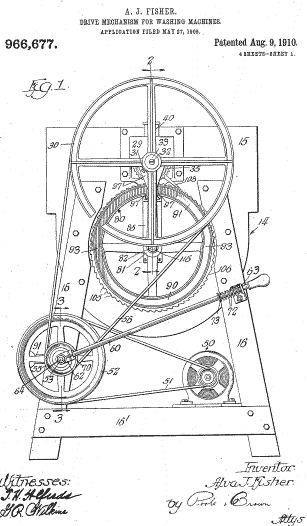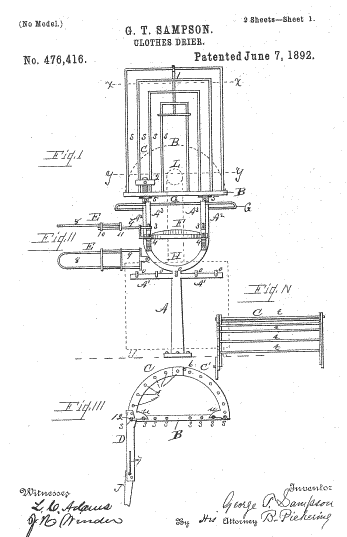 The earliest washing machine – the scrub board was invented in 1797.
The earliest washing machine – the scrub board was invented in 1797.
American, James King patented the first washing machine to use a drum in 1851.
In 1858, Hamilton Smith patented the rotary washing machine.
In 1858, Hamilton Smith patented the rotary washing machine.
In 1874, William Blackstone of Indiana built a birthday present for his wife. It was a machine which removed and washed away dirt from clothes. The first washing machines designed for use in the home.
The first electric-powered washing machine (the Thor) was introduced in 1908, by the Hurley Machine Company of Chicago, Illinois. Alva J. Fisher was the inventor. The machine was a drum type with a galvanized tub and an electric motor, for which a patent was issued on Aug. 9, 1910 (US patent #966677). Here is an example of a 1910 model.
Antique Washing Machine Museum
View Lee Maxwell’s collection of more than 600 old and unusual washing machines. Take a look at his patents of old washing machines.
Now, a little history on a few famous washing machine companies….
The Maytag Corporation began in 1893 when F.L. Maytag began manufacturing farm implements in Newton, Iowa. Business was slow in winter, so to add to his line of products he introduced a wooden-tub washing machine in 1907. Maytag soon devoted himself full-time to the washing machine business.
The Whirlpool Corporation started in 1911 as the Upton Machine Co., founded in St. Joseph, Michigan, to produce electric motor-driven wringer washers.
The origins of the Schulthess Group goes back over 150 years. Here are some highlights that involve washing machine history:
1978 - Launch of first microchip-controlled automatic washing machines
1951 - Production of Europe’s first automatic washing machines
1949 - Invention of punched card control for washing machines
1904 - Production of the first washing machines.
History of The Washing Machine
People first got dirt out of their clothes by pounding them on rocks and washing the dirt away in streams. Sand was used as an abrasive to free the dirt. Soap was discovered at Rome’s Sapo Hill where ashes containing the fat of sacrificial animals was found to have good cleaning powers.
Read More
Clothes Dryers

Clothes dryers were first invented in England and France in the early 1800s. One kind of early clothes dryer was the ventilator. The ventilator was a barrel-shaped metal drum with holes in it. It was turned by hand over a fire.
One of the earliest patent for a clothes dryer(U.S. patent #476,416) was received by George T. Sampson on June 7, 1892. Samson also patented a sled propeller (U.S. patent #312,388) on February 17th, 1885.
Electrical clothes dryers appeared around 1915.
It All Comes Out in the Wash
 Frances Drake”This is a good place to be in a bad mood”, writes Chiori Santiago about a recent trip she made to a San Francisco laundromat. The daunting chore of doing the laundry has dampened people’s spirits even longer than there’s been soap. But Santiago was in for a pleasant surprise. She bypassed the laundromat on the corner ? a purgatory of leaky machines, bad coffee and dog-eared magazines ? and hauled her bags across the bay to the Brain Wash, a different kind of washhouse.
Frances Drake”This is a good place to be in a bad mood”, writes Chiori Santiago about a recent trip she made to a San Francisco laundromat. The daunting chore of doing the laundry has dampened people’s spirits even longer than there’s been soap. But Santiago was in for a pleasant surprise. She bypassed the laundromat on the corner ? a purgatory of leaky machines, bad coffee and dog-eared magazines ? and hauled her bags across the bay to the Brain Wash, a different kind of washhouse.
“Before long my dirty clothes are sloshing away, and I stroll across the floor to the Brain Wash Cafe, where I can buy a latte and settle down with a copy of the free neighborhood weekly”, she writes. “A few minutes later, a musician wedges himself into the strip of space between the roomful of washers and the coffee bar, plugs in his microphone and launches into loud, earnest lyrics accompanied by the bass thrum of dryer cylinders and the soprano whir of gyrating washers. By the time I stuff my clothes into one of the big dryers, I’m dancing across the concrete floor and wishing I had more dirty clothes.”
 Brainwash Americans, whether they do their laundry at home or in self-service establishments, wash a whopping 200 billion pounds of clothing every year, and manufacturers of detergents, stain removers, and washers and dryers spend huge sums to get their products to that insatiable market. Yet in many parts of the world, laundry is still done in the nearest river, stream or lake; the clothes are pounded clean on the rocks and spread in the sun to bleach and dry.
Brainwash Americans, whether they do their laundry at home or in self-service establishments, wash a whopping 200 billion pounds of clothing every year, and manufacturers of detergents, stain removers, and washers and dryers spend huge sums to get their products to that insatiable market. Yet in many parts of the world, laundry is still done in the nearest river, stream or lake; the clothes are pounded clean on the rocks and spread in the sun to bleach and dry.
Santiago traces the history of doing the wash from ancient Egyptian wall paintings showing men doing the scrubbing, twisting and folding, to the modern era automatic washer. She explains the nitty-gritty of soaps and detergents and how they fight dirt at the microscopic level, and visits two research laboratories to learn about products still in the pipeline. Says one researcher, “Those of us who do the laundry don’t get enough credit for the technical decisions we make every day. Some very serious science goes into doing the laundry.”

Hide this content.